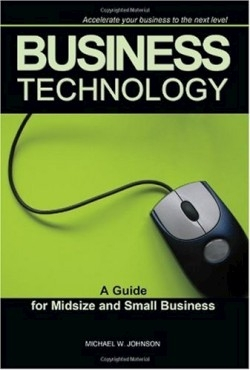Business Technology
A Guide for Midsize and Small Business
As technology costs drop and capabilities rise, small and midsize businesses can leverage products, systems, and services previously available only to large companies. The online world offers an even greater strategic opportunity for small and midsize businesses to look and act like much larger businesses.
In this context, Michael Johnson’s book, Business Technology: A Guide for Midsize and Small Business, is a welcome and valuable addition to the literature on technology. Johnson, who has worked in senior business technology positions for both large and small firms, does an excellent job of presenting a comprehensive overview of virtually every type of technology available to business owners. Most importantly, he presents the information in a readable, easily understandable style, targeted to the non-technical business manager.
Johnson wisely segments available technologies into three categories: functions that relate to outward facing business activities (such as marketing and advertising); core functions related to increasing business efficiency (including accounting and manufacturing control); and business transactions (sending orders, managing the flow of invoices, and the like). He makes the key point that “technology for any business must be tied directly to its business needsÂ…Technology is not a separate entity-it is one more weapon in your armory to make your business the best it can be.”
Business Technology covers the gamut of technology with a broad brushstroke, but in a way that offers an authoritative overview and just enough technical detail. Johnson provides a thorough review of virtually every key general business technology, even those the reader may take for granted. On the hardware side, he covers the PC, mobile computing, printers and scanners, video projection, telephone systems, cameras, microphones, and even shredders. On the software side, he addresses Local Area Networks (LANs), Internet Service Providers (ISPs), and security software.
Then the author presents detailed discussions, augmented by photographs and screenshots, of specific products, systems and services, such as Customer Relationship Management (CRM) systems, video conferencing, document management, and business process management. Johnson appropriately devotes an entire chapter to e-commerce. His chapter on “emerging and future technologies,” which includes biometrics, RFID (Radio Frequency Identification), and cloud computing, is as fascinating as it is informative.
Part II of the book provides a useful discussion of outsourcing business technology, details specific risks to avoid, and offers scenarios that apply to businesses of various sizes. A useful appendix of resources is included.
With its focus squarely on smaller businesses, Business Technology will be of great assistance in helping business owners make the right technology decisions.
Disclosure: This article is not an endorsement, but a review. The publisher of this book provided free copies of the book and paid a small fee to have their book reviewed by a professional reviewer. Foreword Reviews and Clarion Reviews make no guarantee that the publisher will receive a positive review. Foreword Magazine, Inc. is disclosing this in accordance with the Federal Trade Commission’s 16 CFR, Part 255.

